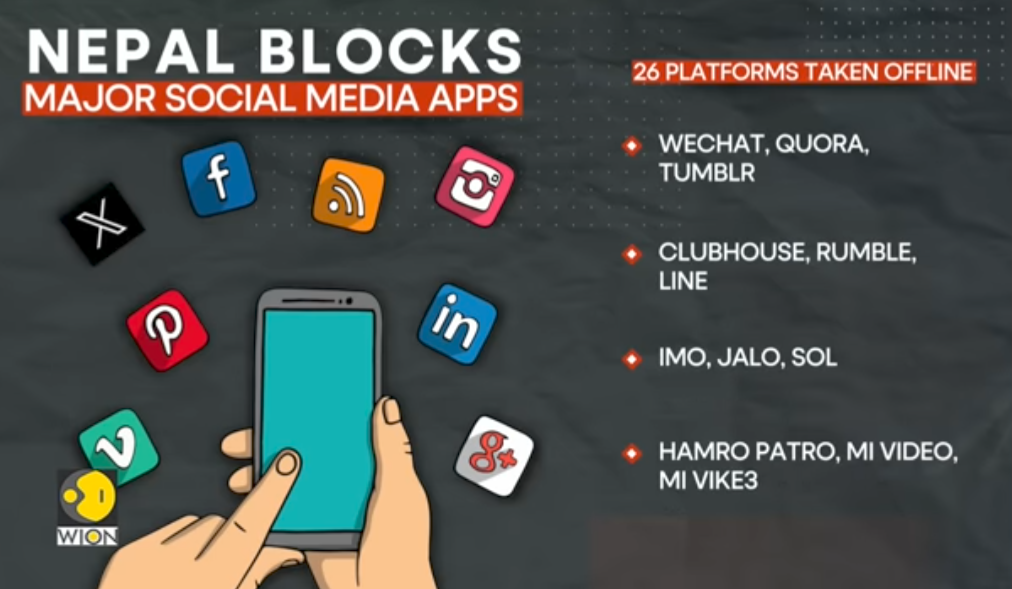
Here are the current events in Nepal and the reasons behind the blocking of popular social media sites:
- Registration is a mandatory requirement.
The Supreme Court of Nepal issued an order in August 2025 mandating that all internet platforms, whether domestic or foreign, register with the Ministry of Communications and Information Technology (MoCIT) before to conducting business in the nation. This involved committing to self-regulation, creating a local presence, and designating a grievance-redressal officer.
2. Failure to Comply
Several reminders since November 2023 and a final seven-day ultimatum on August 28, 2025, failed to get major platforms like Facebook, Instagram, WhatsApp, X (Twitter), YouTube, Reddit, and LinkedIn to register within the allotted time.
3. Enforcement of the Ban Immediately
The Nepal Telecommunications Authority was directed to restrict access to these platforms beginning September 4–5, 2025, due to non-compliance. About 26 prominent platforms are covered by the prohibition.
4. Permitted Exclusions
Platforms that met the registration requirements, such as TikTok, Viber, WeTalk, Nimbuzz, and Poppo Live, are still available. Global Diary and Telegram are awaiting permission.
5. Official Justification
![Screenshot_20250906-070723[1]](https://amitbaa.com/wp-content/uploads/2025/09/Screenshot_20250906-0707231-1.png)
The government argues that the prohibition is required to uphold accountability, prevent disinformation, fight cybercrime, and safeguard social peace and national security.
6. Freedom of Expression Issues
Journalists, press freedom organizations, and digital rights advocates are among the critics who caution that these extensive limitations may suppress free expression and interfere with access to essential business, educational, and communication resources.
Table of Summary
| Component | Details |
|---|---|
| Why Ban? | Platforms failed to register despite multiple notices and Supreme Court directive. |
| Which Apps? | Blocked: Facebook, Instagram, WhatsApp, X, YouTube, LinkedIn, Reddit, etc. |
| Allowed: TikTok, Viber, WeTalk, Nimbuzz, Poppo Live; Telegram, Global Diary under review. | |
| Government’s Stance | Emphasis on accountability, content monitoring, reducing cybercrime and misinformation. |
| Critics’ View | A warning of censorship, threats to free expression and digital livelihoods for Nepalis. |
Here’s a closer look at the reasons behind the recent ban on numerous social media sites by the Nepali government:
- What took place
- From September 4–5, 2025, the Nepali government imposed a ban on more than two dozen social media sites, including popular ones like YouTube, Facebook, Instagram, X (previously Twitter), and WhatsApp.
2. Platforms like TikTok, Viber, WeTalk, Nimbuzz, and Poppo Live, on the other hand, are still available because they met the government’s registration requirements.
2. The Reasons Behind the Ban of These Sites
- Failure to adhere to the Registration Mandate
According to a government decree, all social media businesses had to commit to self-regulation, set up grievance redressal procedures, register with the Ministry of Communications and Information Technology (MoCIT), and open a local liaison office. People who disregarded or didn’t comply with this criteria were barred.
2. Concerns about Social Harmony and National Security
Authorities pointed to growing worries about false information, cybercrime, phony identities, and social unrest brought on by internet material. They maintained that uncontrolled platforms jeopardized public order and safety.
3. Legal Support: New Bill & Supreme Court
The action comes after a Supreme Court order calling for increased responsibility from online companies. At the same time, despite the legislation has not yet been thoroughly discussed, Nepal’s government is debating a comprehensive Social Media Regulation Bill that would formalize these rules.
Impacts & Reactions
- Advocates’ Perspective:
According to the government, the action is required to preserve social cohesion and provide safer, more responsible online environments.
2. Criticism:
Opposition parties, digital rights activists, and human rights organizations contend that this is an overreach that might violate people’s right to free speech and information access. They fear it might create a risky precedent for government regulation of the internet.
3. Public Reaction:
A lot of learners, job searchers, and content producers use sites like YouTube for education and LinkedIn for employment. On social media, their abrupt inaccessibility has sparked annoyance and harsh criticism.
4. Promise of Conditional Reinstatement:
Authorities promised that platforms that were banned might be brought back right away if the registration requirements were followed.
Table of Summary
| Purpose | Government Action & Rationale |
|---|---|
| Enforce Regulation | Platforms must register with MoCIT, appoint local liaison, and self-regulate |
| Ensure Accountability | Enable grievance mechanisms, monitor content, curb misuse |
| Protect Social Harmony | Address misinformation, cybercrime, fake identities |
| Legal Support | Based on Supreme Court directive and pending Social Media Bill |
| Preserve Access (Conditional) | Platforms can return if they comply promptly |